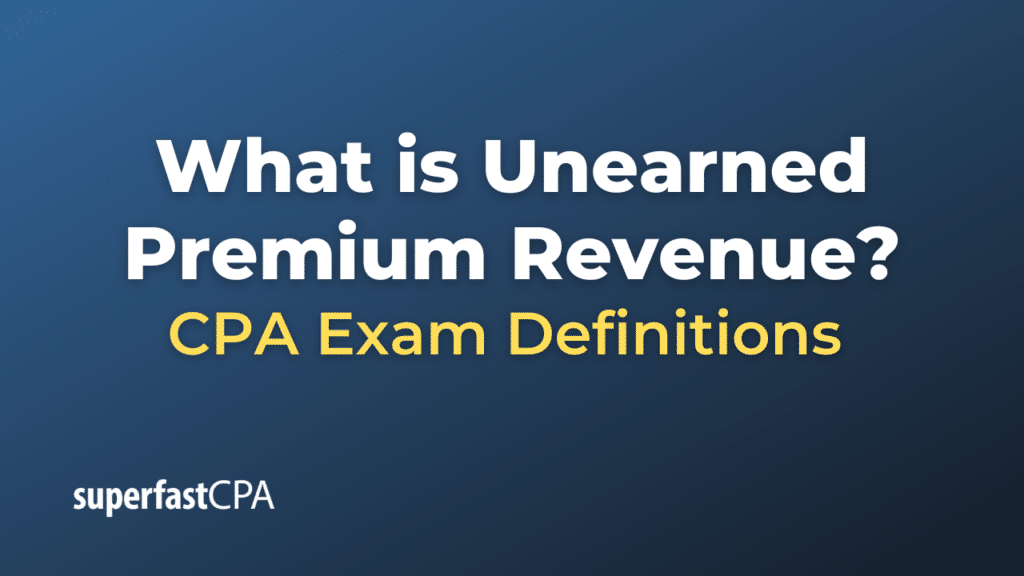Unearned Premium Revenue
Unearned premium revenue, often simply referred to as unearned premiums, is an accounting term commonly used in the insurance industry. It represents the portion of an insurance premium that has been collected but has not yet been “earned” by the insurance company because the coverage period for those premiums extends into the future.
In simpler terms, when an insurance company collects premiums, it is being paid for a promise to provide coverage over a specified period—say, 12 months. However, the insurance company hasn’t fully provided this service until the entire coverage period has passed. Therefore, the portion of the premium related to the future period is considered “unearned” and is recorded as a liability on the insurer’s balance sheet.
How Is It Calculated?
Let’s say you pay $1,200 upfront for a one-year insurance policy. On the first day of the policy, the entire $1,200 would be considered unearned premium revenue because the insurance company has not yet provided any coverage. As time progresses and coverage is provided, the unearned premium decreases, and the amount is transferred to “earned premium revenue” on the income statement.
Here’s a simplified monthly calculation:
- Unearned premium at start: $1,200
- Each month, $100 ($1,200 / 12 months) would be recognized as earned premium revenue.
- After one month, the unearned premium would be $1,100 ($1,200 – $100).
- After six months, the unearned premium would be $600 ($1,200 – $600).
Accounting and Reporting
In accounting terms, unearned premium revenue is recorded as a liability on the balance sheet because it represents an obligation to provide services (insurance coverage) in the future. As the coverage period elapses and the insurance service is effectively “delivered,” the unearned premium revenue is gradually transferred to earned premium revenue, which is reported on the income statement.
Importance for Analysis
Unearned premium revenue is an important metric for both the insurance company and for analysts evaluating the company’s financial health.
- Liquidity: Unearned premiums provide an immediate cash influx, but they are not yet revenue that the company can claim to have fully earned. They essentially act as a short-term loan from the policyholders.
- Profitability: How quickly an insurance company moves premiums from “unearned” to “earned” can impact its apparent profitability during any given reporting period.
- Obligation: The amount of unearned premiums also represents a future obligation, as the insurer must provide coverage or potentially refund premiums if the policy is canceled before the end date.
- Risk Management: High levels of unearned premium revenue may indicate that the company has a robust pipeline of future earnings, but it could also suggest that the company is taking on more risk than it can cover.
Understanding unearned premium revenue is crucial for interpreting the financial statements of insurance companies and can provide valuable insights into their liquidity, profitability, and risk exposure.
Example of Unearned Premium Revenue
Let’s consider a hypothetical example involving an insurance company called “SafeGuard Insurance Co.” to illustrate the concept of unearned premium revenue.
Scenario:
- SafeGuard sells a one-year auto insurance policy to a customer for $1,200.
- The customer pays the full $1,200 upfront.
Accounting at Time of Sale:
- When the premium is initially collected, the entire $1,200 is considered unearned because SafeGuard has not yet provided any insurance services.
- On the balance sheet, SafeGuard would record this $1,200 as a liability under “Unearned Premium Revenue.
Monthly Accounting:
- Each month, SafeGuard “earns” a portion of the premium as it provides coverage. The monthly earned premium would be $1,200 / 12 = $100 per month.
- At the end of each month, SafeGuard would reduce the Unearned Premium Revenue liability by $100 and recognize $100 as Earned Premium Revenue on its income statement.
Balance Sheet and Income Statement Over Time:
At the start:
- Unearned Premium Revenue on Balance Sheet: $1,200
- Earned Premium Revenue on Income Statement: $0
After one month:
- Unearned Premium Revenue on Balance Sheet: $1,100 ($1,200 – $100)
- Earned Premium Revenue on Income Statement: $100
After six months:
- Unearned Premium Revenue on Balance Sheet: $600 ($1,200 – $600)
- Earned Premium Revenue on Income Statement: $600
After twelve months:
- Unearned Premium Revenue on Balance Sheet: $0 (all has been earned)
- Earned Premium Revenue on Income Statement: $1,200
Importance:
- Liquidity: The $1,200 initially boosts SafeGuard’s cash reserves but also represents an obligation to provide future services.
- Profitability : The Earned Premium Revenue gradually accumulates over the year, affecting the company’s reported profitability each month.
- Risk Management: SafeGuard needs to manage its liabilities (including Unearned Premium Revenue) against its assets to ensure it can cover any claims that arise.
By understanding how to manage and account for unearned premium revenue, SafeGuard can better demonstrate its financial stability to both policyholders and investors.













